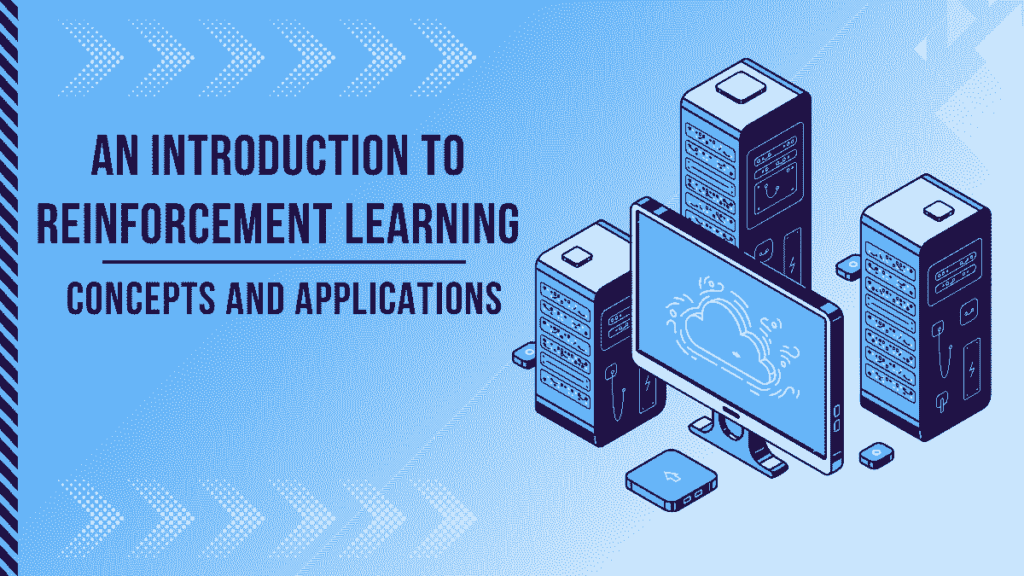In today's technological world, the field of data science is constantly evolving, with new methodologies and applications emerging regularly. One of the most intriguing and rapidly growing areas within data science is reinforcement learning (RL).
Reinforcement learning focuses on teaching an intelligent agent how to act in changing environments to get the most rewards over time. It's one of the three main types of machine learning, along with supervised learning and unsupervised learning.
If you're a professional looking to advance your career in data science, understanding reinforcement learning is crucial. In this blog, we'll cover reinforcement learning: an introduction to help you grasp the fundamentals and appreciate its potential.
What is Reinforcement Learning?
Through action and input from its surroundings, an agent learns to make decisions through reinforcement learning, a kind of machine learning. Maximizing the cumulative benefit over time is the aim.
Reinforcement learning uses an agent that interacts with an environment, investigating and taking advantage of it to determine the best course of action, in contrast to supervised learning, which trains the model on a dataset containing input-output pairs.
Key Components of Reinforcement Learning
Reinforcement learning has several key parts beyond just the basic idea of an agent, its environment, and its goals.
Here are the main components:
- Policy: This is like a set of rules for the agent on how to act in different situations. It maps what the agent sees in the environment to specific actions it should take. For example, a self-driving car might have a policy that tells it to stop when it detects a pedestrian.
- Reward Signal: This shows what the agent is trying to achieve. After each action the agent takes, it either gets a reward or doesn't. The agent's goal is to get as many rewards as possible. For a self-driving car, rewards come from things like shorter travel time, fewer accidents, staying in the right lane, and avoiding sudden stops or starts. Sometimes, multiple rewards guide the agent.
- Value Function: This is different from the reward signal. While the reward signal gives immediate feedback, the value function looks at the long-term benefits. It helps the agent understand how good a particular state is by considering all the possible future states and their rewards.
- Model: This is an optional part of reinforcement learning. A model helps the agent predict what will happen in the environment based on its actions. It can help the agent plan its actions by forecasting outcomes. Some models start with human guidance but then learn on their own.
How Does Reinforcement Learning Work?
The agent interacts with the environment in a loop:
- Observation: The agent observes the current state.
- Action: Based on the policy, the agent takes an action.
- Reward: The environment provides a reward.
- New State: The environment transitions to a new state based on the action.
- Update: The agent updates its policy or value function based on the reward and new state.
This trial-and-error approach allows the agent to learn which actions yield the highest rewards over time.
Inverse Reinforcement Learning
While traditional reinforcement learning focuses on finding the optimal policy given a reward function, inverse reinforcement learning (IRL) aims to determine the reward function given observed behavior. In essence, IRL is about understanding the motivations behind observed actions.
Applications of Inverse Reinforcement Learning
- Robotics: Teaching robots to perform tasks by observing human actions.
- Autonomous Driving: Understanding driving behavior to improve self-driving algorithms.
- Healthcare: Learning from expert decisions to improve treatment strategies.
Real-World Applications of Reinforcement Learning
Reinforcement learning has a wide array of applications across different industries:
Gaming
Reinforcement learning has revolutionized gaming, with agents learning to play complex games like Go, Chess, and video games at superhuman levels. Notable examples include AlphaGo by DeepMind, which defeated world champions in Go.
Robotics
In robotics, RL is used for training robots to perform tasks such as navigating environments, grasping objects & assembling products. These tasks often involve complex sequences of actions and require robust learning mechanisms.
Finance
In finance, RL is employed for algorithmic trading, portfolio management, and risk management. Agents learn to make trading decisions by interacting with financial markets and optimizing for maximum returns.
Healthcare
RL is making strides in healthcare by improving treatment planning, personalized medicine, and drug discovery. By learning from vast amounts of data, RL can suggest optimal treatment strategies and predict patient outcomes.
Autonomous Systems
From self-driving cars to drones, reinforcement learning is pivotal in developing autonomous systems that can navigate and make decisions in real time. These systems learn to operate safely and efficiently in dynamic environments.
Key Algorithms in Reinforcement Learning
Several algorithms are foundational to reinforcement learning:
Q-Learning
A model-free algorithm where the agent learns a value function, Q(s, a), representing the expected utility of taking action a in state s. The goal is to find the optimal policy that maximizes the cumulative reward.
Deep Q-Networks (DQN)
An extension of Q-learning uses deep neural networks to approximate the Q-values. DQN has been successful in learning to play Atari games from raw pixel data.
Policy Gradients
Unlike value-based methods like Q-learning, policy gradient methods directly optimize the policy by adjusting the parameters through gradient ascent. This approach is beneficial for handling large or continuous action spaces.
Actor-Critic Methods
Combines the strengths of value-based and policy-based methods. The actor updates the policy, while the critic evaluates the action by estimating the value function.
Reinforcement Learning: An Introduction to Career Opportunities
Understanding reinforcement learning opens up numerous career opportunities in data science and artificial intelligence. Businesses in a variety of industries are looking for RL specialists to tackle challenging issues and spur innovation.
Skills Required for a Career in Reinforcement Learning
- Mathematics and Statistics: A strong foundation in probability, statistics, and linear algebra.
- Programming: Proficiency in programming languages like Python & familiarity with RL libraries such as TensorFlow and PyTorch.
- Machine Learning: Knowledge of machine learning concepts & algorithms.
- Problem-Solving: Ability to tackle complex problems and design efficient solutions.
Career Paths
- Machine Learning Engineer: Focusing on creating and implementing RL algorithms.
- Data Scientist: Utilizing RL techniques to analyze data and derive actionable insights.
- Research Scientist: Conducting cutting-edge research in RL and publishing findings.
- AI Specialist: Applying RL to build intelligent systems across various industries.
The Final Words
Reinforcement learning is a powerful and dynamic field within data science, offering vast potential for innovation and practical applications. This introduction has covered the core concepts, real-world applications, key algorithms, and challenges of reinforcement learning. For professionals looking to advance their careers in data science, mastering reinforcement learning can open doors to exciting opportunities and cutting-edge research.
By understanding what is reinforcement learning, exploring inverse reinforcement learning, and appreciating the diverse applications of RL, you can position yourself at the forefront of this transformative technology. Whether you're interested in gaming, robotics, finance, healthcare, or autonomous systems, reinforcement learning offers a wealth of possibilities to explore and contribute to.
Elevate Your Career with Imarticus Learning's Data Science and Analytics Course
Take your career to new heights with our meticulously designed data science and analytics course at Imarticus Learning. Every step of this program is crafted to equip you with the skills required for the modern data analyst, helping you land your dream job as a data scientist. This 100% Job Assurance program is ideal for recent graduates and professionals aiming to develop a successful career in data science and analytics.
Our data science course guarantees job placement, offering you 10 assured interviews at over 500 top-tier partner organizations hiring data science and analytics professionals.
Our expert faculty delivers a robust curriculum using interactive modules and hands-on training methods, preparing you to excel in various data science roles.
Apply what you've learned with over 25 real-world projects and case studies specially designed by industry experts to ensure you are job-ready. Take the first step towards a successful data science career with Imarticus Learning.
Enroll Now and transform your future!









